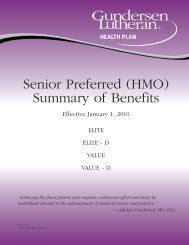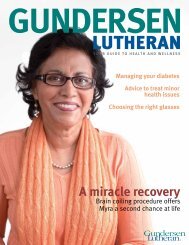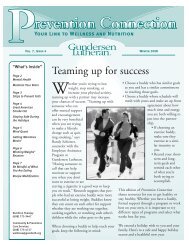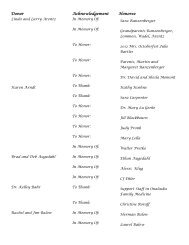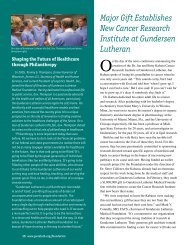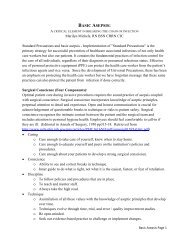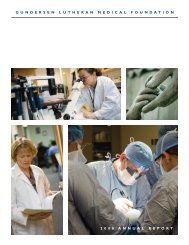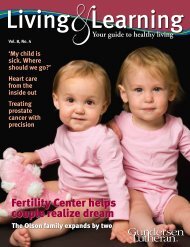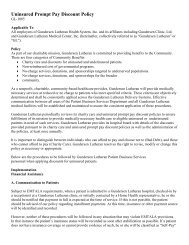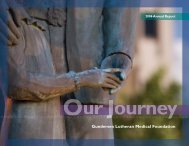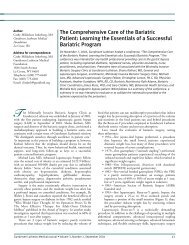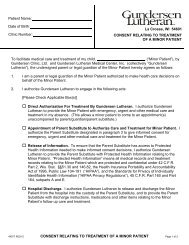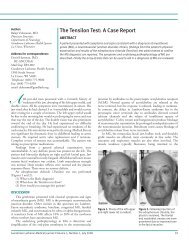Streptococcus bovis - Gundersen Lutheran Health System
Streptococcus bovis - Gundersen Lutheran Health System
Streptococcus bovis - Gundersen Lutheran Health System
Create successful ePaper yourself
Turn your PDF publications into a flip-book with our unique Google optimized e-Paper software.
type of implant, method of sterilization, site of implementation,<br />
and the stress placed on the implant, 1,10 affect the degradation of<br />
biodegradeable implants, often making it difficult to pinpoint<br />
the cause of the an exaggerated inflammatory response. Risk<br />
factors purported to be responsible for adverse tissue responses<br />
are “the presence of quinine dye, an implant with a large surface<br />
area such as a screw, and implant sites with low vascularity.” 11<br />
Our patient had 2 of the aforementioned risk factors: a screw<br />
was employed during the surgery, and repeated physical stress<br />
placed on the anchor-bone interface through the superspinatus<br />
tendon, affirming that these risk factors are potentially valid.<br />
Although bioabsorbable implants are absorbed readily by the<br />
body, thus eliminating the need for a follow-up surgery. They<br />
prevent radiographic obscurities, and they provide incremental<br />
stress transfer as they degrade, which promotes healing. However,<br />
clinicians need to be aware of the drawbacks of bioabsorbable<br />
implants. Compared with metallic implants, they are less strong<br />
and less stiff, have a limited shelf-life, cost more initially, and<br />
have a tendency for an exaggerated inflammatory reaction. The<br />
advantages do, however, appear to outweigh the disadvantages. 10<br />
As shown in the case reported here, the risk of an exaggerated<br />
inflammatory response to bioabsorbable implants increases when<br />
the implant has a large surface area, such as a screw, and when it is<br />
subjected to repeated stress. These risk factors should be considered<br />
in the development of treatment options.<br />
GiAnt CeLL reACtion to A bioAbSorbAbLe iMpLAnt<br />
referenCeS<br />
1. Bollom T, Meister K. Surgical principles: biodegradable materials in sports<br />
medicine. In: DeLee JC, Drez DJ, Miller MD, eds. DeLee & Drez’s Orthopaedic<br />
Sports Medicine: Principles and Practice. 2nd ed. Philadelphia, PA: Saunders;<br />
2003.<br />
2. Kulkarni RK, Pani KC, Neuman C, Leonard F. Polylactic acid for surgical implants.<br />
Arch Surg. 1966;93(5):839-843.<br />
3. Claes LE. Mechanical characterization of biodegradable implants. Clin Mater.<br />
1992;10(1-2):41-46.<br />
4. Ciccone WJ,2nd, Motz C, Bentley C, Tasto JP. Bioabsorbable implants in<br />
orthopaedics: new developments and clinical applications. J Am Acad Orthop Surg.<br />
2001;9(5):280-288.<br />
5. Simon JA, Di Cesare PE, Koval KJ. Bioresorbable materials in orthopaedics. Bull<br />
Hosp Jt Dis. 2000;59(4):232-240.<br />
6. Weiler A, Hoffmann RF, Stahelin AC, Helling HJ, Sudkamp NP. Biodegradable<br />
implants in sports medicine: the biological base. Arthroscopy. 2000;16(3):<br />
305-321.<br />
7. Anderson JM, Rodriguez A, Chang DT. Foreign body reaction to biomaterials.<br />
Semin Immunol. 2008;20(2):86-100.<br />
8. Athanasiou KA, Schmitz JP, Agrawal CM. The effects of porosity on in vitro<br />
degradation of polylactic acid-polyglycolic acid implants used in repair of articular<br />
cartilage. Tissue Eng. 1998;4(1):53-63.<br />
9. Glueck D, Wilson TC, Johnson DL. Extensive osteolysis after rotator cuff repair<br />
with a bioabsorbable suture anchor: a case report. Am J Sports Med. 2005;33(5):<br />
742-744.<br />
10. Ambrose CG, Clanton TO. Bioabsorbable implants: review of clinical experience<br />
in orthopedic surgery. Ann Biomed Eng. 2004;32(1):171-177.<br />
11. Bostman OM, Pihlajamaki HK. Adverse tissue reactions to bioabsorbable fixation<br />
devices. Clin Orthop Relat Res. 2000;(371)(371):216-227.<br />
Graceful John Larson<br />
Optometry<br />
<strong>Gundersen</strong> <strong>Lutheran</strong> Medical Journal • Volume 6, Number 1, June 2009 23




